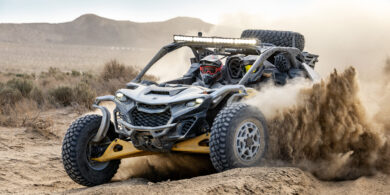July 2, 2007 – Taking a worldwide glimpse of ATV sales
By Matt Bolch
Contributing writer
While ATV sales in the United States still comprise the lion’s share of the global market, manufacturers are scouring the world for the next big market.
For many manufacturers, Europe may be that place. Street-legal ATVs are available in Europe, with a full complement of lights, turn indicators and license plate holders, says Bruce Ramsey, vice president of sales and marketing at KYMCO USA, based in Spartanburg, S.C. KYMCO was one of the first manufacturers to enter the European street-legal market and consequently, captured a sizable percentage of the sales pie. KYMCO is among the top three ATV distributors in that market, Ramsey says.
In its first year in France, for example, the company sold 40,000 units, Ramsey says. “Europe is kind of a niche market for most manufacturers,” Ramsey noted. “Outside the United States, the rest of the ATV market is just 15-20 percent.”
The European ATV market exploded a few years ago, fueled mainly by Asian models under 300cc, says Mark Blackwell, vice president of Victory Motorcycles and international operations at Polaris Industries in Medina, Minn. At its height, models from nearly six dozen manufacturers were available, and it’s no wonder that low prices were driving the growth.
Many of the lower-displacement models were of inferior quality, and there was no parts support available when the units failed, Blackwell says, which led to a backlash against the segment starting in 2005. “The market was soft in 2006 because of the retraction, but when you looked at the detail, the decline was in 300cc-and-under models,” he said. “So while some people didn’t buy another model under 300cc and told their friends about their experience, others chose to move up to the over-300cc market.”
Blackwell describes the overall European market as flat, with growth in some areas, including northern Europe and Russia. However, countries in southern Europe continue to struggle, he says.
“Our belief is that the global sales market was off a little bit last year,” said John Row, press manager at American Honda Motor Co. Inc. in Torrance, Calif. “However, we see a pretty stable year this year.”
ATVs sold outside the United States are treated more like tools than toys, meaning the overall market is not as vulnerable to ruts and gullies, Row said. “A lot of U.S. utility machines are used by hunters, and they can put off a purchase,” Row said. “In the international market, ATVs are more multi-use and utility-based, so they’re less affected by economic factors than recreational models. The rest of the world using ATVs for hunting is not unthinkable, but ask people in France and Germany how many people actually hunt.”
ATVs are used to herd dairy cattle in New Zealand and in snow removal and logging operations in Scandinavian countries. Four-wheelers have become vital parts of those industries and putting off purchases can be compared to a carpenter not buying nails, Row adds.
Arctic Cat, based in Thief River Falls, Minn., credits part of its 9 percent sales rise during its 2007 fiscal year to an increased presence on the international ATV scene. The company’s ATV sales during the year were $431.5 million compared with $394.9 million last year, according to a news release.
“We succeeded in establishing our international dealer-direct distribution network in all major European markets during fiscal 2007, and we expect strong double-digit international growth in fiscal 2008,” said Christopher Twomey, chairman and CEO of Arctic Cat. “Looking ahead, we expect the Prowler (UTV) and international sales to drive further ATV sales growth.”
Land-use issues in France have dampened that market somewhat, Blackwell notes. “There’s a law on the books that technically says you can’t ride an ATV off-road,” he said. An edict from the national government to the provinces to enforce the law came down in late 2005 or early 2006, but the election of Nicolas Sarkozy as the new French president should ease matters since he is an avid outdoorsman, Blackwell adds.
Honda sees the overall European market expanding, says Row. Spain and Portugal have developed into emerging markets in the past five to 10 years, and the United Kingdom generally posts strong sales.
Elsewhere in the world, Australia and New Zealand are also good markets. Those two countries represent extremes in the marketplace, Row says. Australia is in the midst of a multiyear drought, while many ATVs sold in New Zealand are used in the grass-based dairy and sheep industry. ATVs and dogs are used side-by-side to herd dairy cows to rotary milkers and drive sheep from field to field.
“In New Zealand, ATVs are used in some of the most-extreme conditions,” Row said. “They are used at all hours through terrain composed of pumice and volcanic rock and through slews and creeks filled with animal runoff, causing stress on seals, wheels and bearings. The air cleaner often is hideous.”
Polaris recently entered the Russian market, and the company predicts wide acceptance of its products there. China is another growth market, as are Brazil and India. By 2050, Blackwell notes those four countries could surpass the United States in ATV sales.
Row says sales in South Africa often show promise and notes that other African countries have huge sales potential, “but economics plays a role.”




